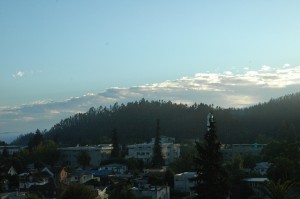 Rain approaching the mountains had forced a change in plans for Easter weekend. We had hoped to spend one last weekend camping in Alto Bio Bio before the rains and cold of Chilean winter set in, but nature had other ideas. As it was too late to reserve a cabaña in the Nevadas de Chillian, we found ourselves grounded at home.
Rain approaching the mountains had forced a change in plans for Easter weekend. We had hoped to spend one last weekend camping in Alto Bio Bio before the rains and cold of Chilean winter set in, but nature had other ideas. As it was too late to reserve a cabaña in the Nevadas de Chillian, we found ourselves grounded at home.
Anyone who had the means to leave the city, in particular those in our neighborhood surrounding the university, had taken flight. Streets that are normally packed, bumper-to-bumper with parked cars, and throngs of students on their way to or from class, were eerily vacant. As I took Teddy for his first walk of the day, the neighborhood felt like something out of Rod Sterling´s, The Twilight Show. There was nary a soul in sight.
At first, I felt left out, left behind, but then realized that I was giving into the pressures of having to keep up, having to compete, having to have and do more, that was so prevalent in my old life in the U.S. So, instead of feeling sorry for our change in circumstance, I thought about the economical divisions that granted freedoms to some, while keeping others bound to the gristmill. I counted my blessings, because although our income was very limiting by U.S. standards, we were able to live in a comfort and enjoy life at a standard that only a small percentage of the Chilean population was able.
While it is usually camping that makes me appreciate how little it takes to be happy in life, it was the weekend without neighbors, without noise, without distractions, that made me appreciate how much we still had with which to be happy. So, by the time, Teddy and I made it back to our nearly vacant apartment building, I had resolved to make the best of the weekend, unpack all of the camping gear and food, and see what could be done to make the weekend still feel special.
Our plans had been gradually changing anyways, with Holy Thursday and Good Friday having turned into workdays, as school had been barely in session by then. Although tired and just wanting a little down time with my mate, I prepared a special Holy Thursday dinner for a dear friend who had lost his Mom to lung cancer. They had been very close, and as I had adopted him as my Chilean brother of choice, and his Mom had adopted me on her deathbed, calling me daughter since I had adopted her son, I put my wants aside and thought about his loss and loneliness. Although Gabriela has passed away the year before, we had been feeling her close during the week, and the dinner was a peaceful, gentle way to remember her in our thoughts.
As is often the nature of an expat, I couldn´t keep from comparing my holiday to those previously known. In Chile, Easter is celebrated with less commercial fanfare than in the U.S. The week itself is called Semana Santa (Saints Week in English), and begins with Palm Sunday, which is known as Domingo de Ramos. On that day, those who go to church carry their own bouquets of palms, often braided, to commemorate Jesus´entry into Jerusalem prior to His arrest. Good Friday is a day of fast, with abstinence from eating meat. Television news programs often feature segments on the availability of mariscos (seafood), where to buy, what varieties people are eating, and who serves up the best restaurant fare. Easter Sunday tends to be a quieter day than the big family day in the U.S. Although European and Hollywood influences have somewhat popularized the pagan symbols of the Easter Bunny and Easter Eggs that have become such a major part of Easter, and their chocolate equivalents are found in grocery and candy stores, the pressure to give baskets and other presents is not as pervasive. Easter still tends to remain what it was originally intended to be, a holy day and week.
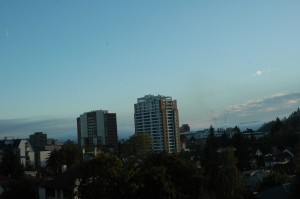 For ourselves, the question remained as to how we should spend our Easter. In the morning, a front of clouds from the sea were slowly marching it´s way across the horizon of hills on the other side of the University (pictured above). After a couple bracing cups of coffee and a simple breakfast of palta (avocado) with crackers, we decided to visit the site of our future home. Although the paperwork was far from finalized, it would be great to plant feet on the soil and gaze out to the Pacific.
For ourselves, the question remained as to how we should spend our Easter. In the morning, a front of clouds from the sea were slowly marching it´s way across the horizon of hills on the other side of the University (pictured above). After a couple bracing cups of coffee and a simple breakfast of palta (avocado) with crackers, we decided to visit the site of our future home. Although the paperwork was far from finalized, it would be great to plant feet on the soil and gaze out to the Pacific.
It had been a couple of months since we visited last, but it took only a “do you want to go home” to Teddy to have him running for collar and leash. As our dream of having a house on soil instead of air began to solidify with each payment, I had taken to calling our site “home,” and telling Teddy that he can go potty on his own property.
One of the aspects that I enjoy immensely on our journey to the site is that we pass through many ocean-side communities, with neighborhoods that undulate with the rolling of the hills all the way down to the Pacific. We pass through Penco, Lirquen, Tomé, Dichato, finally ending at the little, private community where our home will eventually sit, perched on a hill. All of these fishing communities were hard hit by the earthquake and tsunami, and it gives me such satisfaction to see all the changes and rebuilding of both communities and lives.
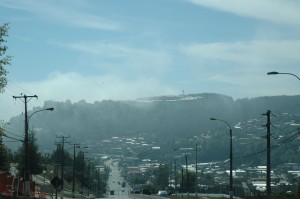 As we entered Lirquen, it became apparent that the front seen from our balcony had taken the form of fog along the shoreline. At first, we were alarmed, thinking that it was a fire, but soon realized that the change in temperature had created a heavy mist. Thoughts of fire were not so far-fetched as all of these towns are bordered on the east by massive pine and eucalyptus farms, which are prone to catch fire during the dry summer months.
As we entered Lirquen, it became apparent that the front seen from our balcony had taken the form of fog along the shoreline. At first, we were alarmed, thinking that it was a fire, but soon realized that the change in temperature had created a heavy mist. Thoughts of fire were not so far-fetched as all of these towns are bordered on the east by massive pine and eucalyptus farms, which are prone to catch fire during the dry summer months.
Fire and fog aren’t the only dangers that lurk en route, as the route itself can present its own challenges. There are certain stretches of the road that make the road signs from the movie, Pee Wee 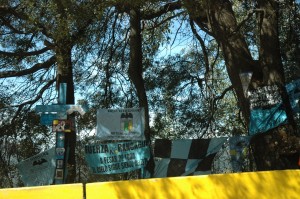 Herman´s Big Adventure, less a stretch of imagination. The squiggle road signs used along the route between towns can´t even begin to forewarn the extreme and congregated hairpin turns that lay ahead. Most stretches of the highway permit speeds of 100 kmh, and although some signs warn to reduce speed, they don´t warn by how much. Sadly, this past February, a bus full of soccer fans from Rancauqua missed a curve and plunged down a cliff near Tomé, resulting in 16 deaths, as well as numerous serious injuries. Concrete roadblocks and robin-egg blue team banners now line the dangerous turn.
Herman´s Big Adventure, less a stretch of imagination. The squiggle road signs used along the route between towns can´t even begin to forewarn the extreme and congregated hairpin turns that lay ahead. Most stretches of the highway permit speeds of 100 kmh, and although some signs warn to reduce speed, they don´t warn by how much. Sadly, this past February, a bus full of soccer fans from Rancauqua missed a curve and plunged down a cliff near Tomé, resulting in 16 deaths, as well as numerous serious injuries. Concrete roadblocks and robin-egg blue team banners now line the dangerous turn.
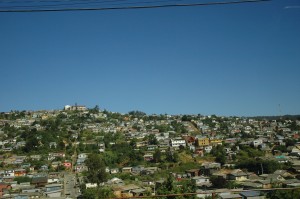 Tomé is a community that is experiencing great changes along its waterfront. Home to the famous lamb’s wool fabric manufacturer, Bellavista Oveja, Tomé is a small city, with houses covering hills as far as the eye can see. It’s residents are often referred to as “having the best legs in Chile” because of all the hills that are walked on a daily basis. Not far from the shoreline, the hills seem to abruptly end.
Tomé is a community that is experiencing great changes along its waterfront. Home to the famous lamb’s wool fabric manufacturer, Bellavista Oveja, Tomé is a small city, with houses covering hills as far as the eye can see. It’s residents are often referred to as “having the best legs in Chile” because of all the hills that are walked on a daily basis. Not far from the shoreline, the hills seem to abruptly end.
Up until the earthquake, attached, one-story houses lined the 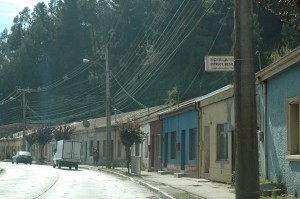 road into the heart of the business district. Each house was painted a different color, according to the owner’s predilection, and gave the impression of a patchwork quilt row. Although humble dwellings, they echoed a certain quaintness of a simpler life. Since the earthquake, as well as the expansion of the route into four lanes, one whole
road into the heart of the business district. Each house was painted a different color, according to the owner’s predilection, and gave the impression of a patchwork quilt row. Although humble dwellings, they echoed a certain quaintness of a simpler life. Since the earthquake, as well as the expansion of the route into four lanes, one whole 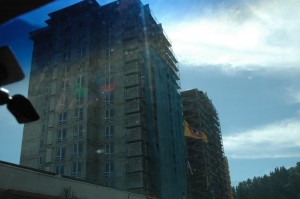 stretch of houses have been bulldozed to make room for several, massive high-rise apartment buildings, which have no aesthetic relationship whatsoever to the rest of the community. Although I have little doubt that such housing is necessary, I can´t help but feel sad for the loss of the architectural character that led the way into town.
stretch of houses have been bulldozed to make room for several, massive high-rise apartment buildings, which have no aesthetic relationship whatsoever to the rest of the community. Although I have little doubt that such housing is necessary, I can´t help but feel sad for the loss of the architectural character that led the way into town.
One change that I was happy to see was the long awaited termination of construction to replace the mediaguas that housed many families in Dichato since the tsunami washed lives, souls and housing away. For the past three years, displaced families were living in rustic, wooden shelters that were hardly bigger than garden storage sheds sold by Sears. These structures lacked insulation, windows and running water, but afforded protection against the winter rains that followed the tsunami. Each family received one small shelter, and had to share communal cleaning facilities, showers and port-a-potties with other residents. It was far from an ideal living situation, and I despaired for their conditions.
As time passed, I worried that what was intended to be temporary housing, would instead become permanent, but then housing construction began across the street. Prefab houses, shipped split in half, were trucked in and set onto concrete slabs. While offering little in variety, except for exterior color of red or white, the houses are a vast improvement to their predecessors.
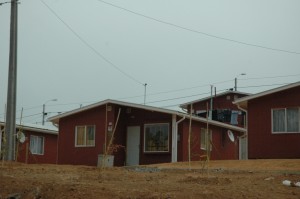 It was good to see curtains finally hanging in the windows, and even lines of laundry supplying the much missing array of color. While uniform in line and color, I have little doubt that with the passage of time, each family will exert their own sense of aesthetics. As we drove past, I noticed that some houses were already bearing signs of structural additions, and changes in door styles. Best of all, the mediaguas, that had once been their homes, were in the process of deconstruction and removal.
It was good to see curtains finally hanging in the windows, and even lines of laundry supplying the much missing array of color. While uniform in line and color, I have little doubt that with the passage of time, each family will exert their own sense of aesthetics. As we drove past, I noticed that some houses were already bearing signs of structural additions, and changes in door styles. Best of all, the mediaguas, that had once been their homes, were in the process of deconstruction and removal.
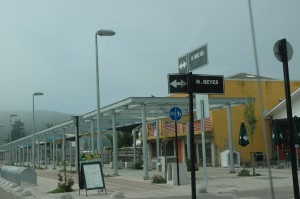 The community of Dichato, itself, also continues to undergo a metamorphosis. The main street was widened, and sports a blocks-long pedestrian walk running along one side. Many commercial structures that were initially built are either being completely replaced with permanent ones, or expanded into multiple stories. Also, buses and trucks are sent along a detour, making the business district more pedestrian-friendly. Although we didn´t stray off the route leading to Pingueral, I could see that the shoreline is also undergoing transformation. Were it not for the ravished structures that still exist, one could almost believe that this was a community being built for the first time.
The community of Dichato, itself, also continues to undergo a metamorphosis. The main street was widened, and sports a blocks-long pedestrian walk running along one side. Many commercial structures that were initially built are either being completely replaced with permanent ones, or expanded into multiple stories. Also, buses and trucks are sent along a detour, making the business district more pedestrian-friendly. Although we didn´t stray off the route leading to Pingueral, I could see that the shoreline is also undergoing transformation. Were it not for the ravished structures that still exist, one could almost believe that this was a community being built for the first time.
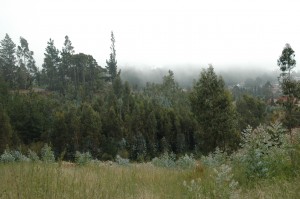 The fog was sitting heavily on Dichato, and I could see drifts of mist floating in. It made the sadness that permeates the permanent residents seem even more palpable that usual. When we were finally standing upon our own site, and watched wispy patches of mist drift up the hill from the sea, I felt as if the souls of those carried away by the tsunami were entering land one more.
The fog was sitting heavily on Dichato, and I could see drifts of mist floating in. It made the sadness that permeates the permanent residents seem even more palpable that usual. When we were finally standing upon our own site, and watched wispy patches of mist drift up the hill from the sea, I felt as if the souls of those carried away by the tsunami were entering land one more.
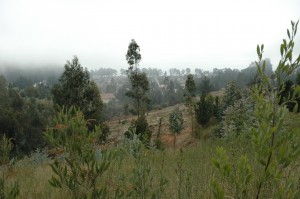 Our own site offered a surprise that we were not quite expecting. The land beyond our site featured a ravine filled with mature pine and eucalyptus trees that had at one time also covered all of the hills. Originally, we had been told that the pine trees would be cut down to increase the view, with smaller height trees being planted in their stead. What we found instead were dirt roads, condominium markers and sewer lines. While disappointing, we reconciled ourselves with having land high enough to not lose complete view of the ocean, and the ability to plant trees and shrubs to hide any objectionable view below.
Our own site offered a surprise that we were not quite expecting. The land beyond our site featured a ravine filled with mature pine and eucalyptus trees that had at one time also covered all of the hills. Originally, we had been told that the pine trees would be cut down to increase the view, with smaller height trees being planted in their stead. What we found instead were dirt roads, condominium markers and sewer lines. While disappointing, we reconciled ourselves with having land high enough to not lose complete view of the ocean, and the ability to plant trees and shrubs to hide any objectionable view below.
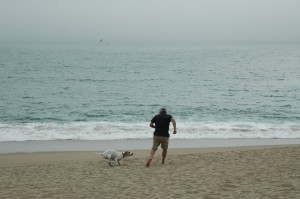 Our original hopes were for peace, tranquility, freedom to play our musical instruments, land to plant a grape arbor, fruit trees and vegetables, and to enjoy easy access to the beach and ocean. All of those qualities will still remain, as well as the sound of the waves as they crash upon the rocks and roll onto the sandy beach, the cries of seagulls and hawks, and the smell of the salty sea air. So, just as we had adjusted to the change in our plans for the weekend, we amended our minds to changes with the landside. Our life was blessed, whether we lived with little or lived with a lot. It was whatever we chose to make it be.
Our original hopes were for peace, tranquility, freedom to play our musical instruments, land to plant a grape arbor, fruit trees and vegetables, and to enjoy easy access to the beach and ocean. All of those qualities will still remain, as well as the sound of the waves as they crash upon the rocks and roll onto the sandy beach, the cries of seagulls and hawks, and the smell of the salty sea air. So, just as we had adjusted to the change in our plans for the weekend, we amended our minds to changes with the landside. Our life was blessed, whether we lived with little or lived with a lot. It was whatever we chose to make it be.